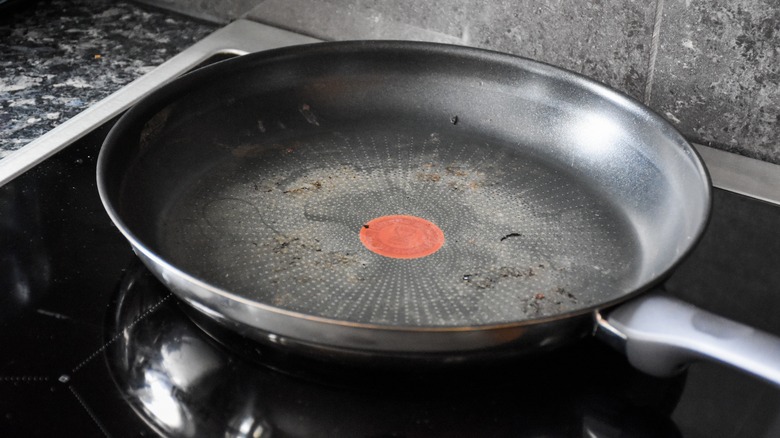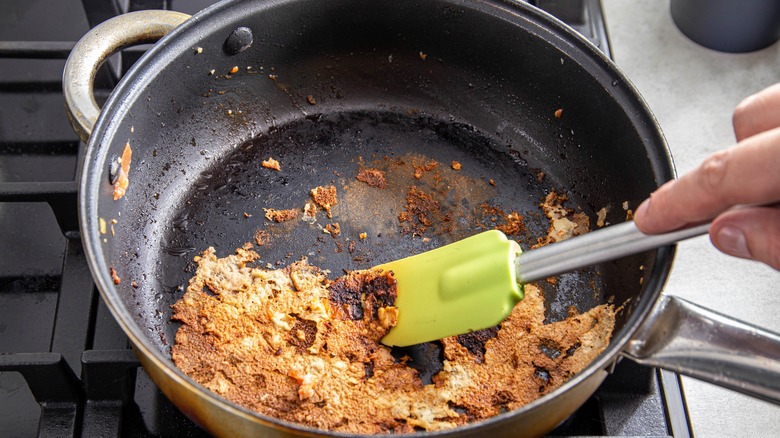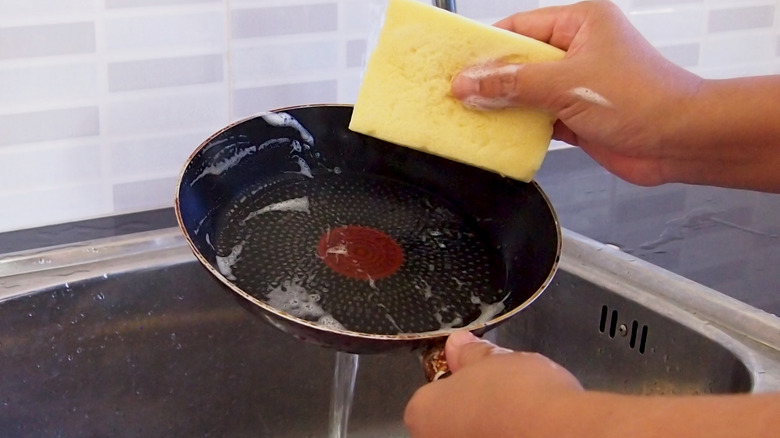The Cleaning Mistakes That Will Ruin Your Non-Stick Pans
When it comes to non-stick pans, Teflon is king. It allows you to cook food of all sorts without worrying about it getting burnt and stuck on, leading to difficult scrubbing later on. But there are some crucial mistakes you may be making when cleaning your Teflon pans that not only ruin them but can actually make them dangerous to cook on.
One major dishwashing mistake is putting your non-stick pan in the dishwasher. This can be extremely tempting as the dishwasher is super convenient, but the cycles also tend to make Teflon susceptible to scratching, which you don't want. Scratching can happen due to the pan bumping into other dishes such as knives or heavy pots and pans, or from the rotating blades and high water pressure eroding the pan's protective coating.
Another easy way to damage your non-stick pan is by using abrasive materials when cleaning it. This can include harsh powders, steel wool, hard bristle brushes, and even the hard side of a sponge. You should also avoid using a magic eraser on non-stick pans, as the chemicals will break down the coating. Even if you're washing by hand, these materials can scratch and deteriorate the Teflon coating, so you still need to be mindful while washing and drying your pans. The trick to maintaining your non-stick pan is to prevent scratches as much as possible.
We don't recommend holding onto scratched non-stick pans
One of the primary characteristics of Teflon-coated cookware is its nonstick surface. When scratched, the coating can compromise its nonstick properties, making food more likely to stick to the surface during cooking. In turn, the lack of non-stick properties will leave you with more stuck-on food, which will require more abrasive cleaning treatments and more scratches will follow, only worsening the problem.
Beyond making for inconvenient cooking and cleaning, scratches can be harmful to your health. Damaging the Teflon coating can expose the underlying metal of the cookware. Small particles of the Teflon coating may break off from the scratched area and mix with food, which may not be inherently dangerous as the Cancer Center notes, but certainly isn't the makings of a delicious meal.
There has been much suspicion over whether or not scratched Teflon pans release dangerous fumes at high temperatures — the answer is that Teflon pans should never reach super high heats (over 500 degrees Fahrenheit), regardless of whether the surface is intact, because at the very least it can surface susceptible to damage, according to Teflon. If you notice significant scratching on your pan, it may be time to replace it, particularly if it was made before 2013 before the toxic PFOAs were phased out of Teflon, which have been identified as a carcinogen by the International Agency for Research on Cancer.
Properly cleaning your non-stick pans
Allow the pan to cool down before cleaning it, as placing a hot pan under cold water can cause warping and damage to the nonstick coating. Teflon pans should be hand-washed using a gentle dishwashing liquid and a soft sponge or cloth — if you're unsure what to use, look at your pan's manufacturing instructions for more details. For stubborn food residues, soak the pan in warm, soapy water for a short period to help loosen them. Avoid soaking for extended periods, as this can potentially damage the coating. Use a non-abrasive sponge or cloth to gently scrub the surface of the pan.
For stubborn residues, you can use a soft bristle brush or a non-metallic scrubber. Baking soda is also considered a gentle abrasive that's generally considered safe for non-stick pans. After cleaning, rinse the pan thoroughly with warm water to remove any soap residue. Use a soft towel to dry the pan thoroughly before storing it. To prevent scratches, avoid stacking Teflon pans directly on top of each other. If you need to stack them, place a soft cloth or paper towel between each pan to provide a protective barrier.
In addition to checking for scratches, you should also note how the pan performs while cooking. If you find that food is consistently sticking to the pan despite proper use and care, it may be time to replace it.


